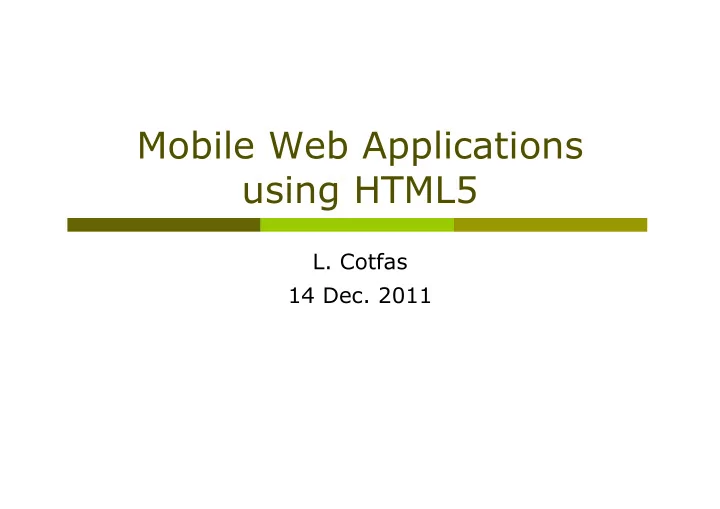

Mobile Web Applications using HTML5 L. Cotfas 14 Dec. 2011
Reasons for mobile web development Many different platforms: Android, IPhone, Symbian, Windows Phone/ Mobile, MeeGo… (only a few of them)
Reasons for mobile web development Targeting more platforms with native apps Higher development and maintenance costs More time needed for development & test Few people have the necessary skills to develop using several platforms
Native applications Advantages Can use all the features of the device Better performance for “resource intensive” client operations Can be sold in popular application stores like: Android, iPhone (also in Operator stores like Orange) Disadvantages Targeting more platforms requires a lot of time and money Slower development cycle Difficult to find developers that know all the platforms.
Simple Web Applications Advantages Can reach any mobile phone with a web browser Can be easily and frequently updated Disadvantages Simple user interface Internet connection is constantly required Can not access the features of the device. Simple CSS, JavaScript, AJAX, HTML5, CSS3 Complex + large no. + smaller no. of devices of devices but increasing fast + users that buy apps and browse the web
Complex Web Applications Characteristics Built using HTML5, AJAX, CSS3 Advantages Can reach any mobile phone with a HTML5 web browser Can access in a standard way ( W3C ) an increasing number of phone features: GPS (Geolocation API), Accelerometer & Gyroscope (DeviceOrientation API) Can be converted to ~native applications that can be sold through an application store Can be easily and frequently updated Advanced UI (comparable wit native applications) Internet connection is not always required.
Complex Web Applications Disadvantages Can not access all the features of the device (but a growing number of standard APIs) Fragmentation - WURFL offers a DB with available features for each phone Worse performance for “resource intensive” client operations Storage space is limited to ~10Mb
* Note Microsoft ~dropped Silverlight as their platform of choice - for web because they consider HTML5 as the only solution for the huge device/ browser /OS fragmentation
HTML5
Available HTML5 mobile browsers The HTML5 standard is not yet finished. The best partial mobile implementations are considered to be: iPhone Android WebOS Other will follow soon
Viewport meta tag In order to prevent the mobile browser from zooming out when loading the page we can add the viewport meta tag to the <head> element. A 980px width is assumed otherwise. We can also specify if the user is able to zoom. The following tag sets the viewport width to the width of the device and disables user zoom: <meta name="viewport" content="user- scalable=no, width=device-width">
Viewport meta tag Without With
UI SDKs Several UI SDKs allow the development of applications that replicate the features of native UI iWebKit (link) jQTouch (link) jQuery Mobile (link) Sencha Touch (link) You can write your own CSS & JavaScript UI
UI SDKs (iWebKit) <!DOCTYPE HTML> <html > <head> <link rel="Stylesheet" type="text/css" href="css/iwebkit.css"> <meta name="viewport" content="user-scalable=no, width=device-width"> <meta content="yes" name="apple-mobile-web-app-capable" /> </head> <body> <div id="topbar"> <div id="title"> Context</div> </div> <div id="content"> <fieldset> <ul class="pageitem"> <li class="checkbox"><span class="name">Distance to POI</span> <input type="checkbox" /> </li> <!-- ….. --> <li class="checkbox"><span class="name">Temperature</span> <input type="checkbox" /> </li> </ul> </fieldset> </div> </body> </html>
Client side storage In the past: Only cookies HTML5 SessionStorage – data is stored with the window object and is discarded upon closing LocalStorage – data is saved after the windows is closed and is available to all pages from the same source WebSQL – offers a JavaScript API to store persistent data in a local SQLite database.
Local/Session Storage Example <!DOCTYPE HTML> <html> <head> <meta http-equiv="Content-Type" content="text/html; charset=utf-8"> <script src="http://ajax.microsoft.com/ajax/jquery/jquery-1.4.4.min.js" type="text/javascript"></script> <title>Session & Local Storage</title> <script type="text/javascript"> $(document).ready(function(){ //Try to set the value from session storage var valueStoredUsingSessionStorage = sessionStorage.getItem('valueStoredUsingSessionStorage'); $('#lbSessionStorage').text(valueStoredUsingSessionStorage); //Try to set the value from local storage var valueStoredUsingLocalStorage = localStorage.getItem('valueStoredUsingLocalStorage'); $('#lbLocalStorage').text(valueStoredUsingLocalStorage); });
Local/Session Storage Example function StoreSessionValue() { var valueStoredUsingSessionStorage = $('#txSessionStorage').val(); sessionStorage.setItem('valueStoredUsingSessionStorage', valueStoredUsingSessionStorage); $('#lbSessionStorage').text(valueStoredUsingSessionStorage); } function StoreLocalValue() { var valueStoredUsingLocalStorage = $('#txLocalStorage').val(); localStorage.setItem('valueStoredUsingLocalStorage', valueStoredUsingLocalStorage); $('#lbLocalStorage').text(valueStoredUsingLocalStorage); } </script> </head> <body> <h1>Session storage</h1> <input id="txSessionStorage" type="text"> <input type="submit" value="Store value" onClick="StoreSessionValue()"><br><br> Currently stored value: <span id="lbSessionStorage"></span> <h1>Local storage</h1> <input id="txLocalStorage" type="text"> <input type="submit" value="Store value" onClick="StoreLocalValue()"><br><br> Currently stored value: <span id="lbLocalStorage"></span> </body> </html>
WebSQL Example < script type = "text/javascript" > var db; $(document).ready(function() { if (!window.openDatabase) { alert('Databases are not supported in this browser.'); return; } var shortName = 'WebSqlDB'; var version = '1.0'; var displayName = 'WebSqlDB'; var maxSize = 65535; db = openDatabase(shortName, version, displayName, maxSize); db.transaction(function(transaction) { transaction.executeSql( 'CREATE TABLE IF NOT EXISTS User ' + ' (UserId INTEGER NOT NULL PRIMARY KEY AUTOINCREMENT,' + ‘ FirstName TEXT NOT NULL, LastName TEXT NOT NULL);', [], function(transaction, result) {;}, errorHandler); ListDBValues(); }); });
WebSQL Example function AddValueToDB() { if (!window.openDatabase) { alert('Databases are not supported in this browser.'); return; } db.transaction(function(transaction) { transaction.executeSql( 'INSERT INTO User(FirstName, LastName) VALUES (?,?)', [$('#txFirstName').val(), $('#txLastName').val()], function() {alert('Record added');}, errorHandler); }); return false; }
WebSQL Example function ListDBValues() { if (!window.openDatabase) { alert('Databases are not supported in this browser.'); return; } $('#lbUsers').html(''); db.transaction(function(transaction) { transaction.executeSql('SELECT * FROM User;', [], function(transaction, result) { if (result != null && result.rows != null) { for (var i = 0; i < result.rows.length; i++) { var row = result.rows.item(i); $('#lbUsers').append('<br>' + row.UserId + '. ' + row.FirstName + ' ' + row.LastName); } } }, errorHandler) }); } function errorHandler(transaction, error) { alert('Error: ' + error.message + ' code: ' + error.code); }
WebSQL Example </script> </head> <body> <h1>WebSQL</h1> <input id="txFirstName" type="text" placeholder="FirstName"> <input id="txLastName" type="text" placeholder="Last Name"> <input type="button" value="Add record" onClick="AddValueToDB()"> <input type="button" value="Refresh" onClick="ListDBValues()"> <br> <br> <span style="font-weight:bold;">Currently stored values:</span><span id="lbUsers"></span> </body> </html>
Location data GPS coordinates can be obtained using the W3C Geolocation API Combining Geolocation API with Google Maps SDKs:
Recommend
More recommend